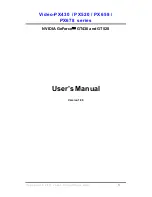
PCI-1711U Series User Manual
20
Chapter 3 Signal Connections
3.1 Overview
Maintaining signal connections is one of the most important factors in
ensuring that your application system is sending and receiving data cor-
rectly. A good signal connection can avoid unnecessary and costly dam-
age to your PC and other hardware devices. This chapter provides useful
information about how to connect input and output signals to the PCI-
1711U cards via the I/O connector.
3.2 Switch and Jumper Settings
PCI-1711U cards have one switch for BoardID setting.
Figure 3.1: Connector and Switch Locations
BoardID settings are used to set a board’s unique identifier when multiple
identical cards are installed in the same system.
PCI-1711U cards have a built-in DIP switch (SW1), which is used to
define each card’s unique identifier. You can determine the unique identi-
fier in the register as shown in Table 3.1. If there are multiple identical
cards in the same chassis, the BoardID switch helps differentiate the
boards by identifying each card’s device number with the switch setting.
The BoardID switch’s unique identifier has been set to 0 at the factory.
Summary of Contents for PCI-1711U Series
Page 1: ...PCI 1711U Series Entry level 100 kS s 12 bit 16 ch PCI Multifunction Card User Manual...
Page 7: ...2 CHAPTER 1 Introduction...
Page 12: ...PCI 1711U Series User Manual 6 Figure 1 1 Installation Flow Chart...
Page 16: ...PCI 1711U Series User Manual 10...
Page 17: ...2 CHAPTER 2 Installation...
Page 24: ...PCI 1711U Series User Manual 18...
Page 25: ...2 CHAPTER 3 Signal Connections...
Page 34: ...PCI 1711U Series User Manual 28...
Page 35: ...2 APPENDIX A Specifications...
Page 40: ...PCI 1711U Series User Manual 34...
Page 41: ...2 APPENDIX B Block Diagrams...
Page 42: ...PCI 1711U Series User Manual 36 Appendix B Block Diagrams...
Page 43: ...2 APPENDIX C Calibration...
















































